“I have no faith in human perfectibility. I think that human exertion will have no appreciable effect upon humanity. Man is now only more active -- not more happy -- nor more wise, than he was 6000 years ago.” -Edgar Allan Poe
It's been quite a fun-filled week for thinking about science and the Universe over at the main Starts With A Bang blog. Just in case you missed anything, this past week (from last Friday to this Thursday) we tackled the following topics:
- Decaying Gravitational Orbits (for Ask Ethan),
- Happy Perfect Number Day (as a special bonus for June 28th),
- An Observatory Made for Fire (for our Weekend Diversion),
- A Southern Sky Surprise, M80 (for Messier Monday),
- What does alien life look like?,
- The most basic unknowable property of matter, and
- How to leave your world for free (for Throwback Thursday).
Some weeks I just get too excited about what's out there, and can't stop myself from writing about more things that I probably should, given my other obligations. But that means more great Starts With A Bang for you, and you had plenty to say about it! Without further ado, here are your Comments of the Week!
Image credit: Petr Scheirich, 2005, via http://sajri.astronomy.cz/asteroidgroups/groups.htm.
From David Hurn on decaying gravitational orbits: "It is interesting that the moon is slowly spiraling away from us, caused by tidal effects I believe."
As I mentioned in the piece, Einstein's General Relativity predicts and additional gravitational decay to the Newtonian one, including in circumstances where the Newtonian circumstance yields no effect at all. A good example of this is the Earth-Moon system. If the Earth was either totally spherical or had its tidal bulge totally in-line with the Earth-Moon line, and if we ignored all the other bodies in the Solar System (like the Sun and the other planets), and if the Earth's rotation lined up exactly with the Moon's (theoretically perfectly circular) orbit around the Earth, it's only General Relativity that would play a role, causing the Moon's orbit to slowly but steadily spiral in and decay, via the emission of gravitational radiation.
 Image credit: © William Newtspeare, 2012, via http://squishtheory.wordpress.com/why-is-the-earths-rotation-slowing/.
Image credit: © William Newtspeare, 2012, via http://squishtheory.wordpress.com/why-is-the-earths-rotation-slowing/.
But David is correct; the system we presently have has the Earth's tidal bulge imperfectly aligned with the Moon's orbit, and therefore the Earth's center of gravity with respect to the Moon is slightly off from its true center of mass. This causes a very slight torque (of a special type, known as a tidal torque), which both causes the Earth's rotational rate to slowly decrease and -- because there's an equal and opposite reaction to that -- for the Moon's orbit around the Earth to slowly spiral outward. For those of you wondering, it will take around 10^20-to-10^30 years for the Newtonian effect to equilibrate enough so that the General Relativity decay starts to dominate the system. May we all have that kind of patience!
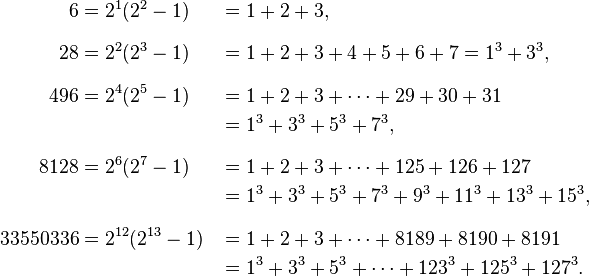 Image credit: screenshot from the Wikipedia page on Perfect Numbers, via http://en.wikipedia.org/wiki/Perfect_number.
Image credit: screenshot from the Wikipedia page on Perfect Numbers, via http://en.wikipedia.org/wiki/Perfect_number.
From Robert on the topic of perfect numbers: "I think there must be a typo, or other mistake in this sentence, as (2^n-1) seems definitely odd to me. Unless there’s a definition of “even perfect number” that I somehow overlooked."
This was my mistake in the text; the (2^n - 1) part is the Mersenne prime that generates perfect numbers. You have to multiply it by 2^(n - 1) to get the perfect number itself, though. This is because you need the only factors of the perfect number candidate to be, in numerical order: 1, 2, 4, ..., 2^(n - 1), 2^n - 1, 2(2^n - 1), 4(2^n - 1), ..., 2^(n - 1)(2^n - 1), which will -- if you exclude the original number -- add up to the original perfect number. My mistake for the mis-statement in that location; it has been corrected.
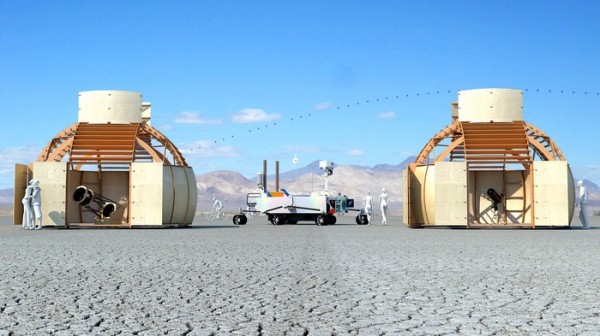 Image credit: Kerry Harrywood, via http://www.blackrockobservatory.com/.
Image credit: Kerry Harrywood, via http://www.blackrockobservatory.com/.
From Admiral Jet Burns on an observatory made for fire, with comments interspersed by me: "Hi there. I’m on this project and can address a few points.
This is really one of my favorite things about writing this blog, by the way: the incredible ability to communicate with and be found/discovered by people doing amazing things all over the world.
1) The domes are portable but do not provide protection from the elements other than the Sun during the day. It will add shade for the scope, and a respite for people in the harsh desert floor.
This makes sense, given the lack of cloud cover, the less-than-1% chance of rain during Burning Man, and the extraordinarily low levels of light pollution that they'll encounter.
2) The Dust environment will be mitigated by a 20″ f4.5 mirror that we will used compressed air to keep swept. It is surprising how dirty the mirror can be yet still provide results.
For those of you who have large Dobsonian-style telescopes and don't know much about maintaining them, it's probably a good idea to never clean your primary mirror. Compressed air can be used to blow dust/dirt off of them, but this advice is dead on: don't worry about cleaning it.
3) We are not doing performance astronomy. We are however connecting people to the cosmos with their own eyes. Thus, the dome is part of the art, the look and feel of what Observatories are. We will not even enforce red light protocols, because we want people to make that connection with the Cosmos.
There are a great number of sights to be had at this time of year. First off, the Moon will be new at the start of Burning Man and only a crescent for most of it, while Saturn and Mars hover near the west in the early evening and many deep-sky objects, including Andromeda and all the objects of the Summer Triangle and Big Dipper should be in full view. It should provide many beautiful sights to anyone who passes by!
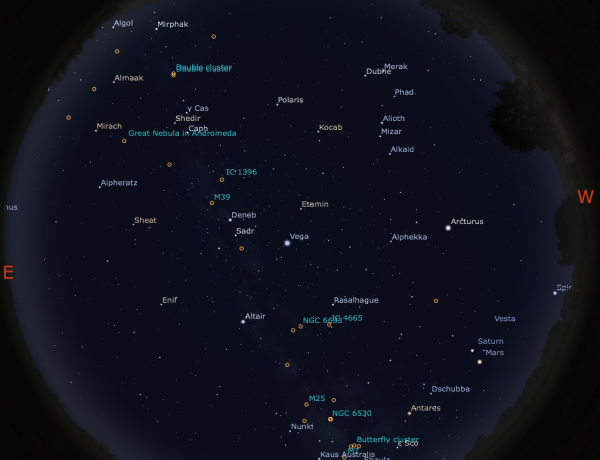 Image credit: me, of the early evening sky near Black Rock Desert, NV, on the night of August 25th. Made using Stellarium.
Image credit: me, of the early evening sky near Black Rock Desert, NV, on the night of August 25th. Made using Stellarium.
4) We will provide information about other astronomy groups where people can get a deeper experience. We are really using the John Dobson ethos of taking telescopes where no telescope has gone before to show people the wonder of the space around them.
Really hard to argue with this one; this seems like something that's just a universal good.
5) We are NOT burning these domes. We will be using them for education and outreach to raise awareness of the Cosmos.
Although this makes my inner 14-year-old-boy very sad, this is probably a smart move. These are beautiful architectural pieces and it would be a shame to lose them because of the tremendous potential for repurposing them.
I hope that helps a bit. We are excited that we are brining this merge of art and science to the public and can’t wait to see you at “home” if you are coming."
Thanks for sharing this, and I hope that everyone who reads this that goes stops by and says hello!
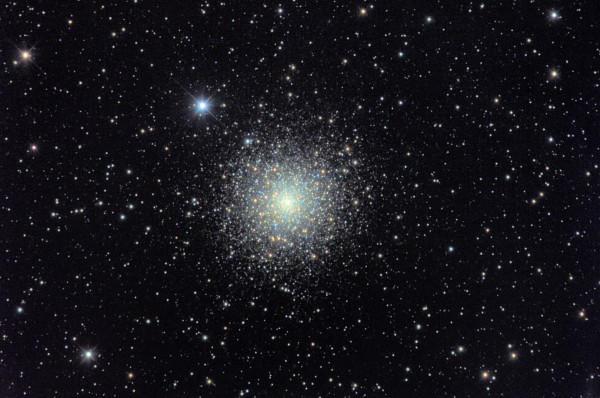 Image credit: Jim Misti of Misti Mountain Observatory, via http://www.mistisoftware.com/astronomy/Clusters_m80.htm.
Image credit: Jim Misti of Misti Mountain Observatory, via http://www.mistisoftware.com/astronomy/Clusters_m80.htm.
From Sinisa Lazarek on our most recent (globular cluster) Messier Monday: "A question, are there any indications that clusters like these have black hole(s) in their centers, or inside the central region. Don’t mean super massive ones, but regular ones, 10-20 Sol m.?"
It would be crazy if there weren't black holes in globular clusters, wouldn't it? Consider that almost every star with an initial mass over about 20-40 solar masses winds up as a black hole, that these clusters were tremendous at their birth with around ~100,000 stars apiece, and that one-in-800 stars is massive enough to go supernova. It would be an awfully big surprise if there weren't small-to-intermediate mass black holes in structures like this. The problem is, unless they're doing some serious feasting, black holes are awfully difficult to detect, but occasionally, we've gotten lucky.
 Image credit: George and Pat of http://www.geoandpat.com/Georgesastrogalaxiesm31.html.
Image credit: George and Pat of http://www.geoandpat.com/Georgesastrogalaxiesm31.html.
This is the Andromeda Galaxy, with its largest globular cluster -- Mayall's Object, labelled "G1" above -- shown on the outskirts. In fact, G1 is the largest globular known overall, with a mass of about 10,000,000 Suns. Using the Hubble Space Telescope and by measuring the velocities of stars near the very center of the cluster, they are able to infer a non-luminous point mass of about 20,000 Suns at the core, and a similar study of Messier 15 -- about 10% the mass of G1 -- showed it has a non-luminous point mass of about 4,000 Suns. Such objects can only be black holes, but we don't yet know if this is a universal phenomenon or something that's restricted to the largest globulars, and has a cutoff at some lower mass.
The search for more knowledge continues.
![Image credit: BESIII Collaboration (Ablikim, M. et al.) Phys.Rev. D87 (2013) 11, 112004 arXiv:1303.3108 [hep-ex].](/files/startswithabang/files/2014/07/etime-600x211.png) Image credit: BESIII Collaboration (Ablikim, M. et al.) Phys.Rev. D87 (2013) 11, 112004 arXiv:1303.3108 [hep-ex].
Image credit: BESIII Collaboration (Ablikim, M. et al.) Phys.Rev. D87 (2013) 11, 112004 arXiv:1303.3108 [hep-ex].
From Michael Kelsey on the topic of the fundamental unknowability of an unstable particle's mass: "The uncertainty relation you quote (dE dT >= hbar) simplifies the true situation. Unstable particles have a line shape described by the Breit-Wigner distribution (like an asymmetric Gaussian with a high tail on the positive side). The “delta-t” is really the full width at half maximum (FWHM) of the particle’s line shape.
Any individual particle has a mass chosen from the BW treated as a probability distribution (technically, a probability density function). In principle, it’s possible for “a single” particle to have a mass two, three, even ten times the particle’s average value (and of course we see some of these, when we make histograms like your figure), albeit with an exponentially suppressed probability."
And this is true; I even referred to the Breit-Wigner distribution in my original post! But this is an important point: every type of unstable particle that we create has an inherent mean mass, where if you create arbitrarily large numbers of them, they'll have an average value for their mass. But they also have an inherent "width," as each individual particle will have a probability of having a particular mass value given by and the Breit-Wigner formula, where M is the particle's mass and Γ is the particle's width, given by the reciprocal of the mean lifetime.
The longer lived a particle is, the smaller its width, all the way down to -- if they're truly stable -- an infinitesimally small width for particles like the proton, electron and photon. Our equipment is not yet sensitive enough to know how stable these things are for certain, though.
And finally...
 Image credit: Wikipedia's page on Rocheworld, via http://en.wikipedia.org/wiki/Rocheworld.
Image credit: Wikipedia's page on Rocheworld, via http://en.wikipedia.org/wiki/Rocheworld.
From John D. Whitehead on how to leave your world for free: "the subject of “jumping from one world to the next” was put forward (pun intended) in a quite entertainging Sci-Fi book “Rocheworld” by Robert L. Forward in 1984"
It should be worth noting that, realistically, if planets get close enough for this, they'll likely merge in short order, at least on geological timescales. But I wasn't inspired from Rocheworld, which sounds great but which I was ignorant of, but by a more modern, lighthearted source of science fiction: Futurama.
As always, all glory to the hypnotoad! Thanks for a great set of comments, and thanks for all you bring to this blog. See you back here soon!

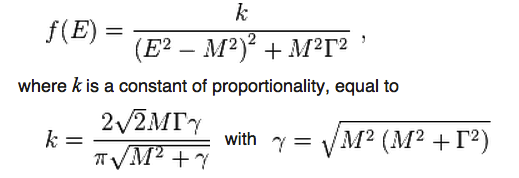
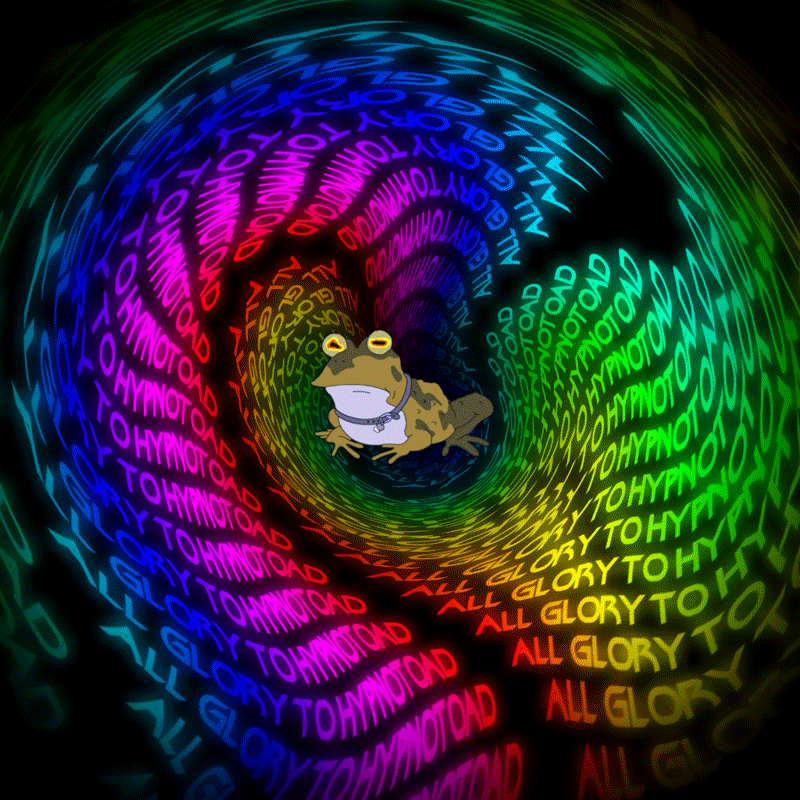
To add to that effect, however small amount, ut was just discovered that the Moon has a similar flexible tidal bulge that is imperfectly aligned. As I remember it, it was LRO observations, not GRAIL, establishing its flex. By symmetry, the same type of torque should be caused.
The tidal forces were larger earlier. A recent hypothesis of why the Moon has lava basins only on the side facing us is that it was tidally locked before its crust had a chance to solidify. Due to the intense "Earth shine" heat at the time, the Earth facing side ended up with half the crustal thickness as the other side solidified first. (As observed by GRAIL.) The difference in thickness explains why impactors could create lava basins asymmetrically.